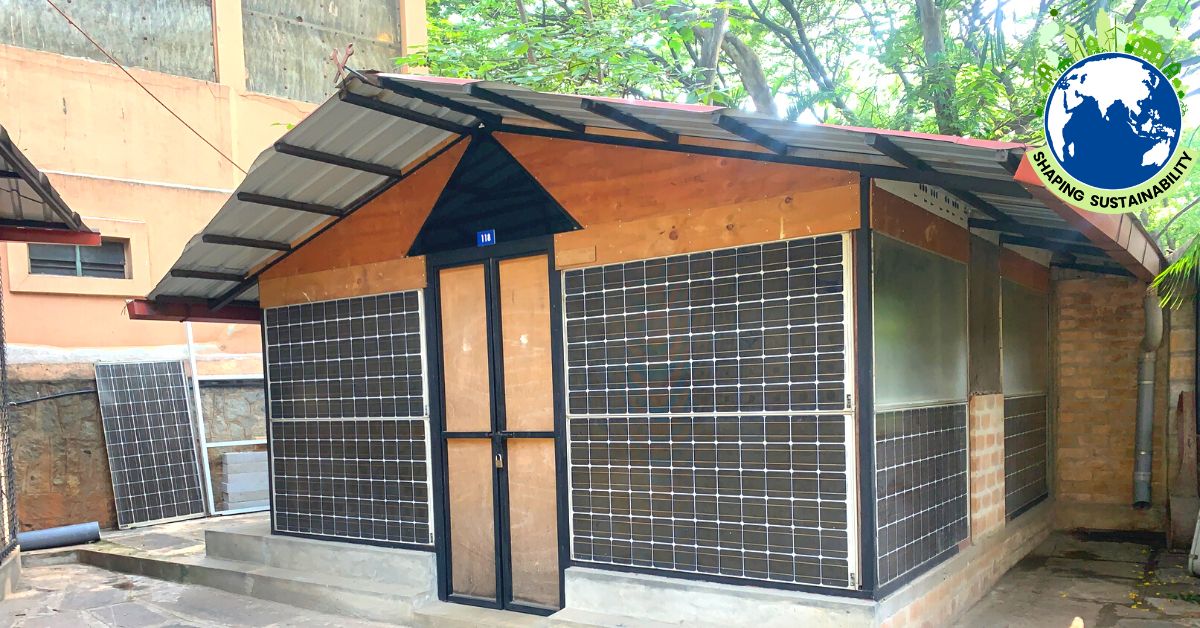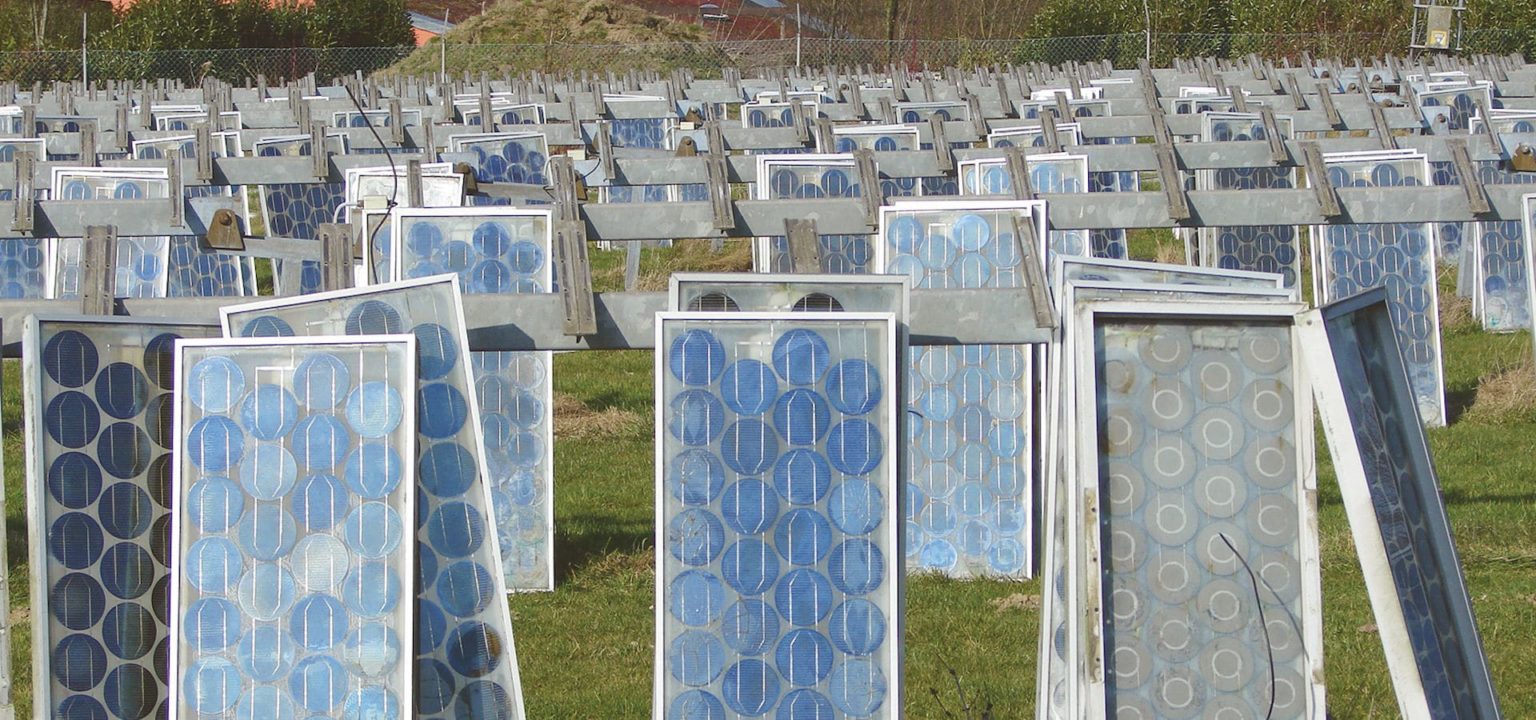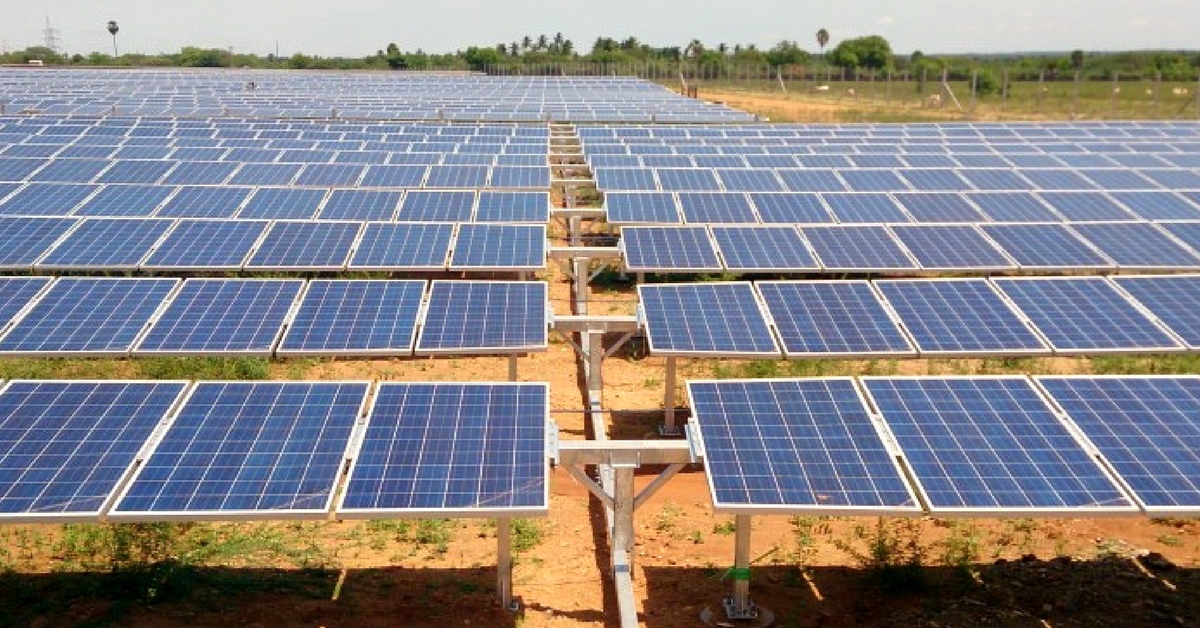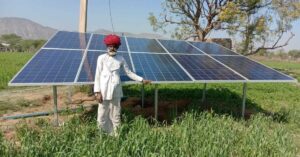IISc Researchers’ Idea Can Turn India’s Dumped Solar Panels Into Sustainable Homes
Solar panels are notoriously difficult to recycle and end up in landfills. This has a severe impact on your health and the environment. However, a team of researchers at the Indian Institute of Science in Bengaluru is exploring whether old discarded solar panels can be reused as building material.

By 2030, the Government of India believes that solar energy will contribute almost 300 gigawatts (GW) to its renewable energy target of 450 GW. Given how solar energy ranks amongst the cheapest forms of electricity in the world, India has gone all-in on the solar energy train.
Image Credit: IISc. Image of the facility built at IISc, employing solar panels
However, India does not yet have a coherent policy on retrieving and managing waste that results from used solar panels or from the manufacturing process.
All that is available in India is a blueprint issued by the Ministry of New and Renewable Energy.
Earlier this year, in response to a question in the Rajya Sabha, RK Singh, the minister, spoke of constituting a central committee to investigate solar power generation waste and create an action plan to evolve a “circular economy” in solar panels through reuse/recycling of waste generated. At present, India considers solar waste as just another element of electronic waste, and discarded solar panels are either left strewn around or eventually get mixed up with domestic solid waste and end up in landfills.
Some estimates suggest that by 2030, India will have more than 200,000 tonnes of solar waste. According to a report by the International Renewable Energy Agency, “large amounts of annual (solar panel) waste are anticipated by the early 2030s” and could touch 78 million tonnes by 2050.
Every year, approximately 6 million metric tonnes of new solar e-waste is going to be generated globally. Given India’s ambition and taste for solar energy, this doesn’t bode well.
Most decommissioned solar panels eventually find their way into landfills, and this has a serious impact on both human health and the environment. These solar cells contain lead, cadmium and other toxic materials that are carcinogenic. When they are dumped in landfills without processing, various studies have shown that they leach out into the soil, cause soil degradation, enter the groundwater, harm the fauna around it and cause adverse health problems.
However, there is a team of researchers at the Centre for Sustainable Technologies (CST), led by Dr Monto Mani and operating out of the Indian Institute of Science (IISc) in Bengaluru, which is exploring whether old discarded solar panels can be upcycled as a building material. With this, they are looking to extend the panels’ useful life by a few decades.
Arriving at a Solution
Solar panels around the world come primarily in three forms—monocrystalline, polycrystalline and thin-film. Irrespective of form, the key component of any solar panel is their solar cells, which are also called photovoltaic (PV) cells. One solar panel is constructed using multiple solar cells. When sunlight hits these PV cells, the light gets converted into electricity.
Most solar panels employ crystalline silicon solar cells “made of silicon atoms connected to one another to form a crystal lattice,” notes an explainer by the United States Office of Energy Efficiency and Renewable Energy. “This lattice provides an organised structure that makes conversion of light into electricity more efficient,” the explainer goes on to add.
These crystalline silicon cells are commonly known to be made of silicon, phosphorus and boron layers, although there are many types of PV cells. But the number of PV cells required in any given solar panel depends on the latter’s size. Once the cells are set out, the panel is sealed and coated with a toughened anti-reflective glass to protect the PV cells within. This toughened glass reflects approximately 2% of the incoming sunlight while allowing the remainder to reach the cells. The panel is then sealed and fitted into a sturdy aluminium frame.
“We took up this project of upcycling decommissioned or discarded solar panels as a building material in August-September 2018. If you look at our earlier work, there are many contributions we have made in terms of understanding how solar photovoltaic panels perform under different conditions. One aspect that we examined closely was how dust affects the performance of solar cells. We also examined how photovoltaics can be integrated in buildings (Building Integrated Photovoltaics/BIPV). The challenge there was how to maximise exposure of the panels to the sun for maximum output, while also seeing how the heat coming into the building can be regulated. After all, in tropical countries that can be a problem,” notes Dr Mani, speaking to The Better India.
Also, as part of their extensive research work, Dr Mani and his team of students have been examining how buildings perform thermally in different climatic zones and looking at low energy building materials. Sometime around the middle of 2018, there was an extension to their laboratory facility that they had to build and were faced with a shortage of funds.
“Coming from an architecture and design background, we thought about whether we really needed funds to buy new materials such as bricks, cement, etc. Instead, why can’t we use decommissioned solar panels that we had stacked up for another experiment where we were examining how they degrade. Our lab set the frame of this structure in place and got some welders to assist. But we did the actual work of installing and fixing the panels,” he says.
One of the motivations for researchers at CST in examining decommissioned solar panels as a building material is because they comprise materials that are inherently very durable.
And thus began a serious consideration by the team towards the ‘waste problem’ plaguing solar panels.

The Waste Problem
In solar panels, you have the glass, EVA with solar cells sandwiched and then a Tedlar backsheet. It’s very hard to separate each element once they are fused together. In countries like Germany, they adopt thermos-chemical processes to recover/extract the silicon alone. We don’t have any such economically viable facilities in India. More importantly, we also do not have a structured mechanism to retrieve discarded PV panels for processing. Instead, what happens here is that the toughened glass is shattered and broken into small pieces, the aluminium frame is salvaged and the silicon is chemically extracted for lower grade semiconductor applications.
The difficulty is in retrieving these panels to a centralised facility where they can be processed. People discard solar panels wherever they are used once their output decreases. There is no mechanism to salvage, recover and collect decommissioned solar panels at a particular place. Many of these panels, as a result, eventually get mixed up with solid waste and end up in landfills.
“At these landfills, the panels get crushed, and once in the ground, they are exposed to other constituents of the soil, groundwater, etc. Chemicals present in these discarded panels tend to leach out like lead, tin, or other proprietary elements that manufacturers are using to coat the silicon. They will not disclose the details of what chemicals are used but I am not so sure that they are entirely harmless when they end up in landfills,” says Dr Mani.
These solar panels are designed for a service life of about 25 years.
“Although durable, they could be decommissioned as early as 10-12 years, particularly at large scale installations. Why is that the case? At IISc, we decommissioned our set of solar panels after 10 years because their productivity dropped to almost 50% of their original output. Also, the solar cells cracked and moisture ingress had happened. As a research facility, we decided to bring in some newer panels and started examining them as well,” he explains.
The scenario is different when you’re putting up solar panels at home.
Residents could keep them running for 20 years or more because they’re not really worried (or in the know) about how much the output is going down. As long as they work, they are kept in use.
But looking at large scale solar plants, if the output of a few panels starts to go down and the plant has already recovered the cost gone into its investment, the operators will tend to decommission it and invest in a newer generation of solar PVs. In the future, a significant source of these decommissioned panels will be mega solar power plants.
“Panels are like batteries. You can’t have an old battery and a new battery put together in an array. In solar power plants, if you have 24 solar panels and four of them are defective, they will isolate the entire array and replace them with fresh ones. Thus, a trickle of panels will grow into an ocean of discarded panels. When their economic viability goes down, that’s when panels are likely to be pulled down earlier than their intended service life,” he says.

For The Future
“As of now, major power plants simply discard the panels alongside it because there is no mechanism to retrieve and process them. There is no organised or centralised system to collect end of life, decommissioned solar panels, and they are just left wherever they’re being used. The local garbage collector or waste picker will pick up the discarded panels and throw them somewhere and that goes into the landfill. The answer to photovoltaics being a viable building material lies in a centralised place where decommissioned and discarded panels are retrieved/collected and sorted in terms of how much output each panel can still generate,” says Dr Mani.
This will allow designers, builders and architects to see what panels they can integrate into buildings. It could be used as a building material and if a degraded panel is still offering 40% of its original output, people can use that to power their Wi-Fi points, among other applications.
“The main quality of these solar panels as a building material is that they use toughened glass on one side. Newer panels are using toughened glass on the back side as well. These are designed to withstand wind loads, and hail and by and large, they are very durable. The only constraint is that you can’t cut these panels to size. You have to work with the size that you get depending on the manufacturer. Otherwise, it’s like working with glass,” he observes.
These discarded panels make for superb facades. Dr Mani’s team even made a dining table out of these discarded and used smaller ones even as chopping boards. However, he does warn that as much as possible, people should avoid tampering with the backside of the panel, rupturing or trying to peel it off. “As long as you’re in contact with the glass side of the panel, you’ll be fine,” he adds.
Dr Mani and his team are still examining the facility they have built using solar panels for its thermal performance. It’s a thin material compared to a brick wall. They are trying to see whether the panels cause excessive heating and how they work in different climatic zones.
“We will be examining it from the air quality point of view as well. We are looking at collaborators in the polymer sciences and see whether they can shed some light on how they would deteriorate. We will do an accelerated ageing test on these panels to see what kind of chemicals are leaching out. We are assessing whether there’s a risk of the backsheet turning brittle or powdery and that powder spreading into the indoor environment. After all, scientific evidence is emerging that microplastics are found in people’s lungs and blood. I’m not saying these have been traced to photovoltaics yet, but from the regular plastic, we are using on a day to day basis. Without shattering it, the photovoltaics don’t pose any additional concerns when used as it is. Prima facie, the risk is low. It’s like using any plastic. However, for a scientist to say this with certainty, it will take some time,” he says.
Moreover, Dr Mani and his team will be coming up with guidelines on how to use these panels as a building material.
“It will take about two years or more for the information to surface and be accessible. We are also giving additional guidelines like don’t expose backsheets, and give another layer of plywood using recycled packaged wood.”
(Edited by Vinayak Hegde)
Additional Sources:
United States Office of Energy Efficiency and Renewable Energy
‘India lacks solar waste handling policy’ by Jacob Koshy; Published on 17 February 2022 courtesy The Hindu
‘The Afterlife of Solar Panels’ by Mahashri Ranjith Kumar; Published on 23 May 2022 courtesy The Wire
Like this story? Or have something to share? Write to us: [email protected], or connect with us on Facebook and Twitter.
If you found our stories insightful, informative, or even just enjoyable, we invite you to consider making a voluntary payment to support the work we do at The Better India. Your contribution helps us continue producing quality content that educates, inspires, and drives positive change.
Choose one of the payment options below for your contribution-
By paying for the stories you value, you directly contribute to sustaining our efforts focused on making a difference in the world. Together, let's ensure that impactful stories continue to be told and shared, enriching lives and communities alike.
Thank you for your support. Here are some frequently asked questions you might find helpful to know why you are contributing?


This story made me
-
97
-
121
-
89
-
167














